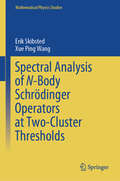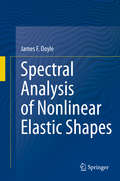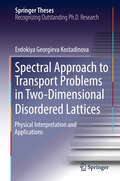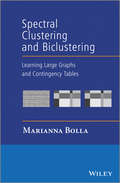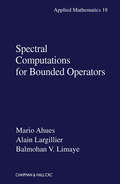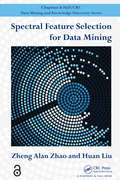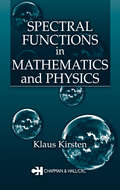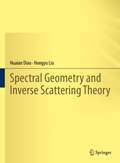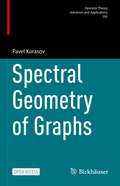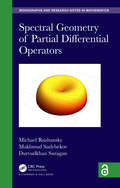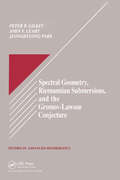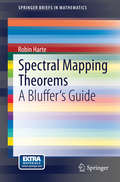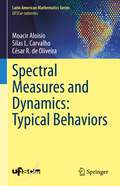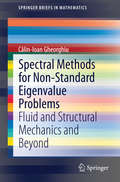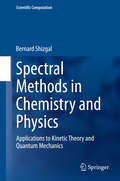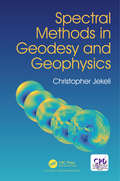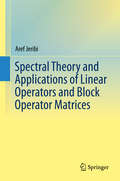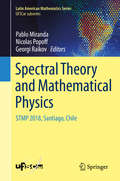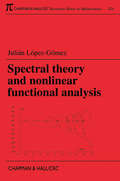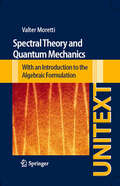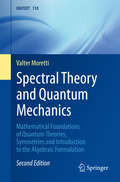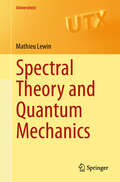- Table View
- List View
Spectral Analysis of N-Body Schrödinger Operators at Two-Cluster Thresholds (Mathematical Physics Studies)
by Erik Skibsted Xue Ping WangThis book provides a systematic study of spectral and scattering theory for many-body Schrödinger operators at two-cluster thresholds. While the two-body problem (reduced after separation of the centre of mass motion to a one-body problem at zero energy) is a well-studied subject, the literature on many-body threshold problems is sparse. However, the authors’ analysis covers for example the system of three particles interacting by Coulomb potentials and restricted to a small energy region to the right of a fixed nonzero two-body eigenvalue. In general, the authors address the question: How do scattering quantities for the many-body atomic and molecular models behave within the limit when the total energy approaches a fixed two-cluster threshold? This includes mapping properties and singularities of the limiting scattering matrix, asymptotics of the total scattering cross section, and absence of transmission from one channel to another in the small inter-cluster kinetic energy region. The authors’ principal tools are the Feshbach–Grushin dimension reduction method and spectral analysis based on a certain Mourre estimate. Additional topics of independent interest are the limiting absorption principle, micro-local resolvent estimates, Rellich- and Sommerfeld-type theorems and asymptotics of the limiting resolvents at thresholds. The mathematical physics field under study is very rich, and there are many open problems, several of them stated explicitly in the book for the interested reader.
Spectral Analysis of Nonlinear Elastic Shapes
by James F. DoyleThis book concerns the elastic stability of thin-walled structures — one of the most challenging problems facing structural engineers because of its high degree of nonlinearity — and introduces the innovative approach of using spectral analysis of the shapes and the stiffness to gain insights into the nonlinear deformations. The methodology greatly facilitates correlating the shape changes with the stiffness changes. Professor Doyle also develops specific computer procedures that complement finite element methods so that the ideas and methods are applicable to general structural problems. Basic validity of the procedures is established using key archetypal problems from buckling/post-buckling of columns, arches, curved plates, and cylindrical shells, all worked out in significant detail. The book is ideal for a wide variety of structural engineers, particularly those in aerospace and civil fields. Researchers in computational mechanics also find a rich source of new ideas for post-processing data from nonlinear analyses.
Spectral Approach to Transport Problems in Two-Dimensional Disordered Lattices: Physical Interpretation And Applications (Springer Theses)
by Evdokiya Georgieva KostadinovaThis book introduces the spectral approach to transport problems in infinite disordered systems characterized by Anderson-type Hamiltonians. The spectral approach determines (with probability one) the existence of extended states for nonzero disorder in infinite lattices of any dimension and geometry. Here, the author focuses on the critical 2D case, where previous numerical and experimental results have shown disagreement with theory. Not being based on scaling theory, the proposed method avoids issues related to boundary conditions and provides an alternative approach to transport problems where interaction with various types of disorder is considered.Beginning with a general overview of Anderson-type transport problems and their relevance to physical systems, it goes on to discuss in more detail the most relevant theoretical, numerical, and experimental developments in this field of research. The mathematical formulation of the innovative spectral approach is introduced together with a physical interpretation and discussion of its applicability to physical systems, followed by a numerical study of delocalization in the 2D disordered honeycomb, triangular, and square lattices. Transport in the 2D honeycomb lattice with substitutional disorder is investigated employing a spectral analysis of the quantum percolation problem. Next, the applicability of the method is extended to the classical regime, with an examination of diffusion of lattice waves in 2D disordered complex plasma crystals, along with discussion of proposed future developments in the study of complex transport problems using spectral theory.
Spectral Clustering and Biclustering: Learning Large Graphs and Contingency Tables
by Marianna BollaExplores regular structures in graphs and contingency tables by spectral theory and statistical methods This book bridges the gap between graph theory and statistics by giving answers to the demanding questions which arise when statisticians are confronted with large weighted graphs or rectangular arrays. Classical and modern statistical methods applicable to biological, social, communication networks, or microarrays are presented together with the theoretical background and proofs. This book is suitable for a one-semester course for graduate students in data mining, multivariate statistics, or applied graph theory; but by skipping the proofs, the algorithms can also be used by specialists who just want to retrieve information from their data when analysing communication, social, or biological networks. Spectral Clustering and Biclustering: Provides a unified treatment for edge-weighted graphs and contingency tables via methods of multivariate statistical analysis (factoring, clustering, and biclustering). Uses spectral embedding and relaxation to estimate multiway cuts of edge-weighted graphs and bicuts of contingency tables. Goes beyond the expanders by describing the structure of dense graphs with a small spectral gap via the structural eigenvalues and eigen-subspaces of the normalized modularity matrix. Treats graphs like statistical data by combining methods of graph theory and statistics. Establishes a common outline structure for the contents of each algorithm, applicable to networks and microarrays, with unified notions and principles.
Spectral Computations for Bounded Operators
by Mario Ahues Alain Largillier Balmohan LimayeExact eigenvalues, eigenvectors, and principal vectors of operators with infinite dimensional ranges can rarely be found. Therefore, one must approximate such operators by finite rank operators, then solve the original eigenvalue problem approximately. Serving as both an outstanding text for graduate students and as a source of current results for
Spectral Feature Selection for Data Mining (Chapman And Hall/crc Data Mining And Knowledge Discovery Ser.)
by Huan Liu Zheng Alan ZhaoSpectral Feature Selection for Data Mining introduces a novel feature selection technique that establishes a general platform for studying existing feature selection algorithms and developing new algorithms for emerging problems in real-world applications. This technique represents a unified framework for supervised, unsupervised, and semisupervise
Spectral Functions in Mathematics and Physics
by Klaus KirstenThe literature on the spectral analysis of second order elliptic differential operators contains a great deal of information on the spectral functions for explicitly known spectra. The same is not true, however, for situations where the spectra are not explicitly known. Over the last several years, the author and his colleagues have developed new,
Spectral Geometry and Inverse Scattering Theory
by Hongyu Liu Huaian DiaoInverse scattering problems are a vital subject for both theoretical and experimental studies and remain an active field of research in applied mathematics. This book provides a detailed presentation of typical setup of inverse scattering problems for time-harmonic acoustic, electromagnetic and elastic waves. Moreover, it provides systematical and in-depth discussion on an important class of geometrical inverse scattering problems, where the inverse problem aims at recovering the shape and location of a scatterer independent of its medium properties. Readers of this book will be exposed to a unified framework for analyzing a variety of geometrical inverse scattering problems from a spectral geometric perspective. This book contains both overviews of classical results and update-to-date information on latest developments from both a practical and theoretical point of view. It can be used as an advanced graduate textbook in universities or as a reference source for researchers in acquiring the state-of-the-art results in inverse scattering theory and their potential applications.
Spectral Geometry of Graphs (Operator Theory: Advances and Applications #293)
by Pavel KurasovThis open access book gives a systematic introduction into the spectral theory of differential operators on metric graphs. Main focus is on the fundamental relations between the spectrum and the geometry of the underlying graph.The book has two central themes: the trace formula and inverse problems.The trace formula is relating the spectrum to the set of periodic orbits and is comparable to the celebrated Selberg and Chazarain-Duistermaat-Guillemin-Melrose trace formulas. Unexpectedly this formula allows one to construct non-trivial crystalline measures and Fourier quasicrystals solving one of the long-standing problems in Fourier analysis. The remarkable story of this mathematical odyssey is presented in the first part of the book.To solve the inverse problem for Schrödinger operators on metric graphs the magnetic boundary control method is introduced. Spectral data depending on the magnetic flux allow one to solve the inverse problem in full generality, this means to reconstruct not only the potential on a given graph, but also the underlying graph itself and the vertex conditions.The book provides an excellent example of recent studies where the interplay between different fields like operator theory, algebraic geometry and number theory, leads to unexpected and sound mathematical results. The book is thought as a graduate course book where every chapter is suitable for a separate lecture and includes problems for home studies. Numerous illuminating examples make it easier to understand new concepts and develop the necessary intuition for further studies.
Spectral Geometry of Partial Differential Operators (Chapman & Hall/CRC Monographs and Research Notes in Mathematics)
by Michael Ruzhansky Durvudkhan Suragan Makhmud SadybekovThe aim of Spectral Geometry of Partial Differential Operators is to provide a basic and self-contained introduction to the ideas underpinning spectral geometric inequalities arising in the theory of partial differential equations. Historically, one of the first inequalities of the spectral geometry was the minimization problem of the first eigenvalue of the Dirichlet Laplacian. Nowadays, this type of inequalities of spectral geometry have expanded to many other cases with number of applications in physics and other sciences. The main reason why the results are useful, beyond the intrinsic interest of geometric extremum problems, is that they produce a priori bounds for spectral invariants of (partial differential) operators on arbitrary domains. Features: Collects the ideas underpinning the inequalities of the spectral geometry, in both self-adjoint and non-self-adjoint operator theory, in a way accessible by anyone with a basic level of understanding of linear differential operators Aimed at theoretical as well as applied mathematicians, from a wide range of scientific fields, including acoustics, astronomy, MEMS, and other physical sciences Provides a step-by-step guide to the techniques of non-self-adjoint partial differential operators, and for the applications of such methods. Provides a self-contained coverage of the traditional and modern theories of linear partial differential operators, and does not require a previous background in operator theory.
Spectral Geometry, Riemannian Submersions, and the Gromov-Lawson Conjecture (Studies in Advanced Mathematics)
by Peter B. Gilkey JeongHyeong Park John V. LeahyThis cutting-edge, standard-setting text explores the spectral geometry of Riemannian submersions. Working for the most part with the form valued Laplacian in the class of smooth compact manifolds without boundary, the authors study the relationship-if any-between the spectrum of Dp on Y and Dp on Z, given that Dp is the p form valued Laplacian and pi: Z (R) Y is a Riemannian submersion.After providing the necessary background, including basic differential geometry and a discussion of Laplace type operators, the authors address rigidity theorems. They establish conditions that ensure that the pull back of every eigenform on Y is an eigenform on Z so the eigenvalues do not change, then show that if a single eigensection is preserved, the eigenvalues do not change for the scalar or Bochner Laplacians. For the form valued Laplacian, they show that if an eigenform is preserved, then the corresponding eigenvalue can only increase. They generalize these results to the complex setting as well. However, the spinor setting is quite different. For a manifold with non-trivial boundary and imposed Neumann boundary conditions, the result is surprising-the eigenvalues can change.Although this is a relatively rare phenomenon, the authors give examples-a circle bundle or, more generally, a principal bundle with structure group G where the first cohomology group H1(G;R) is non trivial. They show similar results in the complex setting, show that eigenvalues can decrease in the spinor setting, and offer a list of unsolved problems in this area.Moving to some related topics involving questions of positive curvature, for the first time in mathematical literature the authors establish a link between the spectral geometry of Riemannian submersions and the Gromov-Lawson conjecture.Spectral Geometry, Riemannian Submersions, and the Gromov-Lawson Conjecture addresses a hot research area and promises to set a standard for the field. Researchers and applied mathematicians interested in mathematical physics and relativity will find this work both fascinating and important.
Spectral Mapping Theorems
by Robin HarteWritten by an author who was at the forefront of developments in multi-variable spectral theory during the seventies and the eighties, this guide sets out to describe in detail the spectral mapping theorem in one, several and many variables. The basic algebraic systems - semigroups, rings and linear algebras - are summarised, and then topological-algebraic systems, including Banach algebras, to set up the basic language of algebra and analysis. Spectral Mapping Theorems is written in an easy-to-read and engaging manner and will be useful for both the beginner and expert. It will be of great importance to researchers and postgraduates studying spectral theory.
Spectral Measures and Dynamics: Typical Behaviors (Latin American Mathematics Series)
by César R. de Oliveira Moacir Aloisio Silas L. CarvalhoThis book convenes and deepens generic results about spectral measures, many of them available so far in scattered literature. It starts with classic topics such as Wiener lemma, Strichartz inequality, and the basics of fractal dimensions of measures, progressing to more advanced material, some of them developed by the own authors.A fundamental concept to the mathematical theory of quantum mechanics, the spectral measure relates to the components of the quantum state concerning the energy levels of the Hamiltonian operator and, on the other hand, to the dynamics of such state. However, these correspondences are not immediate, with many nuances and subtleties discovered in recent years.A valuable example of such subtleties is found in the so-called “Wonderland theorem” first published by B. Simon in 1995. It shows that, for some metric space of self-adjoint operators, the set of operators whose spectral measures are singular continuous is a generic set (which, for some, is exotic). Recent works have revealed that, on top of singular continuity, there are other generic properties of spectral measures. These properties are usually associated with a number of different notions of generalized dimensions, upper and lower dimensions, with dynamical implications in quantum mechanics, ergodicity of dynamical systems, and evolution semigroups. All this opens ways to new and instigating avenues of research.Graduate students with a specific interest in the spectral properties of spectral measure are the primary target audience for this work, while researchers benefit from a selection of important results, many of them presented in the book format for the first time.
Spectral Methods Using Multivariate Polynomials On The Unit Ball (Chapman & Hall/CRC Monographs and Research Notes in Mathematics)
by Kendall Atkinson Olaf Hansen David ChienSpectral Methods Using Multivariate Polynomials on the Unit Ball is a research level text on a numerical method for the solution of partial differential equations. The authors introduce, illustrate with examples, and analyze 'spectral methods' that are based on multivariate polynomial approximations. The method presented is an alternative to finite element and difference methods for regions that are diffeomorphic to the unit disk, in two dimensions, and the unit ball, in three dimensions. The speed of convergence of spectral methods is usually much higher than that of finite element or finite difference methods. Features Introduces the use of multivariate polynomials for the construction and analysis of spectral methods for linear and nonlinear boundary value problems Suitable for researchers and students in numerical analysis of PDEs, along with anyone interested in applying this method to a particular physical problem One of the few texts to address this area using multivariate orthogonal polynomials, rather than tensor products of univariate polynomials.
Spectral Methods for Non-Standard Eigenvalue Problems
by Călin-Ioan GheorghiuThis book focuses on the constructive and practical aspects of spectral methods. It rigorously examines the most important qualities as well as drawbacks of spectral methods in the context of numerical methods devoted to solve non-standard eigenvalue problems. In addition, the book also considers some nonlinear singularly perturbed boundary value problems along with eigenproblems obtained by their linearization around constant solutions. The book is mathematical, poising problems in their proper function spaces, but its emphasis is on algorithms and practical difficulties. The range of applications is quite large. High order eigenvalue problems are frequently beset with numerical ill conditioning problems. The book describes a wide variety of successful modifications to standard algorithms that greatly mitigate these problems. In addition, the book makes heavy use of the concept of pseudospectrum, which is highly relevant to understanding when disaster is imminent in solving eigenvalue problems. It also envisions two classes of applications, the stability of some elastic structures and the hydrodynamic stability of some parallel shear flows. This book is an ideal reference text for professionals (researchers) in applied mathematics, computational physics and engineering. It will be very useful to numerically sophisticated engineers, physicists and chemists. The book can also be used as a textbook in review courses such as numerical analysis, computational methods in various engineering branches or physics and computational methods in analysis.
Spectral Methods in Chemistry and Physics
by Bernard ShizgalThis book is a pedagogical presentation of the application of spectral and pseudospectral methods to kinetic theory and quantum mechanics. There are additional applications to astrophysics, engineering, biology and many other fields. The main objective of this book is to provide the basic concepts to enable the use of spectral and pseudospectral methods to solve problems in diverse fields of interest and to a wide audience. While spectral methods are generally based on Fourier Series or Chebychev polynomials, non-classical polynomials and associated quadratures are used for many of the applications presented in the book. Fourier series methods are summarized with a discussion of the resolution of the Gibbs phenomenon. Classical and non-classical quadratures are used for the evaluation of integrals in reaction dynamics including nuclear fusion, radial integrals in density functional theory, in elastic scattering theory and other applications. The subject matter includes the calculation of transport coefficients in gases and other gas dynamical problems based on spectral and pseudospectral solutions of the Boltzmann equation. Radiative transfer in astrophysics and atmospheric science, and applications to space physics are discussed. The relaxation of initial non-equilibrium distributions to equilibrium for several different systems is studied with the Boltzmann and Fokker-Planck equations. The eigenvalue spectra of the linear operators in the Boltzmann, Fokker-Planck and Schrödinger equations are studied with spectral and pseudospectral methods based on non-classical orthogonal polynomials. The numerical methods referred to as the Discrete Ordinate Method, Differential Quadrature, the Quadrature Discretization Method, the Discrete Variable Representation, the Lagrange Mesh Method, and others are discussed and compared. MATLAB codes are provided for most of the numerical results reported in the book - see Link under 'Additional Information' on the the right-hand column.
Spectral Methods in Geodesy and Geophysics
by Christopher JekeliThe text develops the principal aspects of applied Fourier analysis and methodology with the main goal to inculcate a different way of perceiving global and regional geodetic and geophysical data, namely from the perspective of the frequency, or spectral, domain rather than the spatial domain. The word "methods" in the title is meant to convey that the transformation of a geophysical signal into the spectral domain can be applied for purposes of analysis as well as rapid computation. The text is written for graduate students; however, Chapters 1 through 4 and parts of 5 can also benefit undergraduates who have a solid and fluent knowledge of integral and differential calculus, have some statistical background, and are not uncomfortable with complex numbers. Concepts are developed by starting from the one-dimensional domain and working up to the spherical domain, which is part of every chapter. Many concepts are illustrated graphically with actual geophysical data primarily from signals of gravity, magnetism, and topography.
Spectral Spaces (New Mathematical Monographs #35)
by Max Dickmann Niels Schwartz Marcus TresslSpectral spaces are a class of topological spaces. They are a tool linking algebraic structures, in a very wide sense, with geometry. They were invented to give a functional representation of Boolean algebras and distributive lattices and subsequently gained great prominence as a consequence of Grothendieck's invention of schemes. There are more than 1,000 research articles about spectral spaces, but this is the first monograph. It provides an introduction to the subject and is a unified treatment of results scattered across the literature, filling in gaps and showing the connections between different results. The book includes new research going beyond the existing literature, answering questions that naturally arise from this comprehensive approach. The authors serve graduates by starting gently with the basics. For experts, they lead them to the frontiers of current research, making this book a valuable reference source.
Spectral Theory and Applications of Linear Operators and Block Operator Matrices
by Aref JeribiExamining recent mathematical developments in the study of Fredholm operators, spectral theory and block operator matrices, with a rigorous treatment of classical Riesz theory of polynomially-compact operators, this volume covers both abstract and applied developments in the study of spectral theory. These topics are intimately related to the stability of underlying physical systems and play a crucial role in many branches of mathematics as well as numerous interdisciplinary applications. By studying classical Riesz theory of polynomially compact operators in order to establish the existence results of the second kind operator equations, this volume will assist the reader working to describe the spectrum, multiplicities and localization of the eigenvalues of polynomially-compact operators.
Spectral Theory and Mathematical Physics: STMP 2018, Santiago, Chile (Latin American Mathematics Series #254)
by Georgi Raikov Pablo Miranda Nicolas PopoffThis proceedings volume contains peer-reviewed, selected papers and surveys presented at the conference Spectral Theory and Mathematical Physics (STMP) 2018 which was held in Santiago, Chile, at the Pontifical Catholic University of Chile in December 2018. The original works gathered in this volume reveal the state of the art in the area and reflect the intense cooperation between young researchers in spectral theoryand mathematical physics and established specialists in this field. The list of topics covered includes: eigenvalues and resonances for quantum Hamiltonians; spectral shift function and quantum scattering; spectral properties of random operators; magnetic quantum Hamiltonians; microlocal analysis and its applications in mathematical physics. This volume can be of interest both to senior researchers and graduate students pursuing new research topics in Mathematical Physics.
Spectral Theory and Nonlinear Functional Analysis (Chapman & Hall/CRC Research Notes in Mathematics Series)
by Julian Lopez-GomezThis Research Note addresses several pivotal problems in spectral theory and nonlinear functional analysis in connection with the analysis of the structure set of zeroes of a general class of nonlinear operators. Appealing to a broad audience, it contains many important contributions to linear algebra, linear functional analysis, nonlinear functional analysis, and topology. The author gives several applications of the abstract theory to reaction diffusion equations and systems. The results presented cover a thirty-year period and cut across a variety of mathematical fields.
Spectral Theory and Quantum Mechanics
by Valter MorettiThis book pursues the accurate study of the mathematical foundations of Quantum Theories. It may be considered an introductory text on linear functional analysis with a focus on Hilbert spaces. Specific attention is given to spectral theory features that are relevant in physics. Having left the physical phenomenology in the background, it is the formal and logical aspects of the theory that are privileged. Another not lesser purpose is to collect in one place a number of useful rigorous statements on the mathematical structure of Quantum Mechanics, including some elementary, yet fundamental, results on the Algebraic Formulation of Quantum Theories. In the attempt to reach out to Master's or PhD students, both in physics and mathematics, the material is designed to be self-contained: it includes a summary of point-set topology and abstract measure theory, together with an appendix on differential geometry. The book should benefit established researchers to organise and present the profusion of advanced material disseminated in the literature. Most chapters are accompanied by exercises, many of which are solved explicitly.
Spectral Theory and Quantum Mechanics
by Valter MorettiThis book pursues the accurate study of the mathematical foundations of Quantum Theories. It may be considered an introductory text on linear functional analysis with a focus on Hilbert spaces. Specific attention is given to spectral theory features that are relevant in physics. Having left the physical phenomenology in the background, it is the formal and logical aspects of the theory that are privileged. Another not lesser purpose is to collect in one place a number of useful rigorous statements on the mathematical structure of Quantum Mechanics, including some elementary, yet fundamental, results on the Algebraic Formulation of Quantum Theories. In the attempt to reach out to Master's or PhD students, both in physics and mathematics, the material is designed to be self-contained: it includes a summary of point-set topology and abstract measure theory, together with an appendix on differential geometry. The book should benefit established researchers to organise and present the profusion of advanced material disseminated in the literature. Most chapters are accompanied by exercises, many of which are solved explicitly.
Spectral Theory and Quantum Mechanics (Universitext)
by Mathieu LewinThis textbook presents the spectral theory of self-adjoint operators on Hilbert space and its applications in quantum mechanics. Based on a course taught by the author in Paris, the book not only covers the mathematical theory but also provides its physical interpretation, offering an accessible introduction to quantum mechanics for students with a background in mathematics. The presentation incorporates numerous physical examples to illustrate the abstract theory. The final two chapters present recent findings on Schrödinger’s equation for systems of particles. While primarily designed for graduate courses, the book can also serve as a valuable introduction to the subject for more advanced readers. It requires no prior knowledge of physics, assuming only a graduate-level understanding of mathematical analysis from the reader.
Spectral Theory and its Applications
by Bernard HelfferBernard Helffer's graduate-level introduction to the basic tools in spectral analysis is illustrated by numerous examples from the Schrödinger operator theory and various branches of physics: statistical mechanics, superconductivity, fluid mechanics and kinetic theory. The later chapters also introduce non self-adjoint operator theory with an emphasis on the role of the pseudospectra. The author's focus on applications, along with exercises and examples, enables readers to connect theory with practice so that they develop a good understanding of how the abstract spectral theory can be applied. The final chapter provides various problems that have been the subject of active research in recent years and will challenge the reader's understanding of the material covered.
